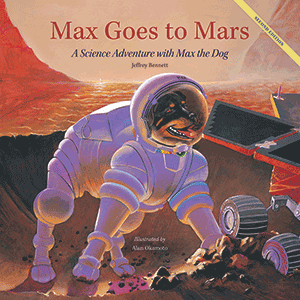 Max Goes to Mars was illustrated by Alan Okamoto. Alan worked from real models for the main characters (Tori, Commander Grant, and Max) who posed for the scenes; he then added the backgrounds as needed for the different Earth and space scenes. Additional characters were sometimes based on real people and sometimes not. Below is a list of some special things to look for in the paintings. We have also included a few other special notes of interest.
Max Goes to Mars was illustrated by Alan Okamoto. Alan worked from real models for the main characters (Tori, Commander Grant, and Max) who posed for the scenes; he then added the backgrounds as needed for the different Earth and space scenes. Additional characters were sometimes based on real people and sometimes not. Below is a list of some special things to look for in the paintings. We have also included a few other special notes of interest.
- Cover: We see Max as we see him later on p. 18, looking apprehensively at the Spirit rover, which landed on Mars in 2004.
- p. 3: The scene is set in front of the 18-inch telescope at the Sommers-Bausch Observatory on the campus of the University of Colorado, Boulder. Notice that Commander Grant is holding a globe of Mars; the boy resting in Commander Grant’s arms is actually the author’s son, Grant — for whom Commander Grant is named. As noted in the credits on p. 2, the model for Commander Grant is Lado Jurkin, one of the "Lost Boys of Sudan" who now lives and works in Colorado. For grownups who wish to learn more about the Lost Boys, we highly recommend Dave Eggers’ book What is the What. Among the other children in the painting are the author’s daughter, Brooke, hugging Max; and the observatory director’s daughter, Sophie Duncan, wearing glasses.
- p. 4-5: Notice the gullies on the mountainside, which echo gullies shown on Mars on p. 19. The gullies on Mars, discovered in photographs taken from orbiting spacecraft, are an important topic of study. Scientists hope they will help reveal more about subsurface water on Mars.
- p. 6: Be sure to see the video of Max doing his famous merry-go-round trick.
- p. 7: The illustration here is based on the Voyage scale model solar system on the National Mall in Washington, DC. This project was originally started by the author of the Max series. Voyage models are now being built in many other communities around the world. Learn more at this link on the author’s personal web site.
- p. 8: Is Max really listening closely to Tori? No… you can see he’s actually looking at the squirrel in the tree above her head.
- p. 9: In the dream bubbles, we see Tori imagining a scene from H.G. Wells’ novel War of the Worlds, while Max imagines playing frisbee tug-o-war with a fire-breathing squirrel.
- p. 10: The scene shown here is based on the Mars exhibit at the Denver Museum of Nature and Science. Visitors to the exhibit are always outside the glass, like the man and boy shown in the painting. They are supposed to be imagining that they are inside a Mars colony, looking out the window to the Martian surface. For that reason, the museum normally only allows museum staff to appear behind the glass in the "outside" part of Mars, and the staff always wear space suits out there since that would be required on the real Mars. But for the purposes of this painting, the museum allowed Tori and Max to go behind the glass anyway; they did not have any spacesuits that fit Max, so we decided to show them without the suits; it’s safe, after all, since this is only a pretend Mars, not the real Mars that they visit later in the book.
- p. 11: The image shown on the large flat screen TV is based on this real photo from the Spirit rover. Also notice the signs for "no dogs," "no food," and "no drink" under the screen — with all three rules obviously violated as Max licks up spilled food and drink!
- p. 12: Be sure to notice that this scene takes place on the Moon, where the rocket to Mars will launch from. Once you have a Moon colony, it make sense to launch rockets to Mars from there, rather than from Earth, since the Moon’s weaker gravity makes it much more fuel-efficient to sent rockets outward.
- p. 13: It looks like Commander Grant is getting an upside-down lick from Max, but of course they are both weightless, and there is no up or down in space when you are weightless. You may also notice that the mission patch on Commander Grant’s flight suit is the same one used on the frisbee in Max Goes to the Moon.
- p. 14: The TV screen shows Tori’s reflection as she looks at the tiny Earth and Moon, which you can see just above her reflected image. The inset in the lower left of the screen shows the view aboard the Mars ship, where you can see Commander Grant holding his video camera to look out the window and capture the image that Tori is seeing.
- p. 15: As the ship swings around Mars, you can see the small moon Phobos above the ship and, farther off in the distance, the even smaller Deimos.
- p. 16-17: This painting actually shows a time sequence, an idea invoked by the change from daylight at the left to darkness at the right. At the far left you can see the parachute from the landing. The left page also shows Max and Commander Grant at the door of the rover, while at the right we see Max playing ball with an astronaut outside one of the greenhouses.
- p. 18: We see Max at the Spirit rover. The story takes place in the future, so it says the Spirit rover stopped working many years ago. But in real life, in 2009, the rover is still going! Both Spirit and its twin, Opportunity, arrived on Mars in January, 2004, and were expected to work for only about 3 months. But they are still going strong more than 5 years later. You might think of them as the "energizer bunnies" of Mars!
- p. 19: As noted for p. 4-5, here we see gullies on the crater wall in the background.
- p. 20-21: Although the story talks about seeing the tiny blue Earth shining in the Martian dawn, you can’t actually see it in this painting because it would be located behind the astronauts to the left. You can tell from the shadows: Earth must always be on the same side of the sky as the Sun as viewed from Mars, since it is closer to the Sun than Mars; for the same reason, we always see Mercury and Venus on the same side of our sky as we see the Sun. So as the Sun comes up in the east, Earth must be higher in the eastern sky. You can tell that east is behind the astronauts because of the way the sunlight shines on their spacesuits.
- p. 22: This scene is quite low still along the base of Olympus Mons, in a little canyon along the great mountain’s perimeter.
- p. 23: Amazingly, artist Alan Okamoto painted this painting just a few weeks before the Spirit rover recorded the first actual video of a dust devil on the surface of Mars. But we already knew that dust devils — some quite large — are common because photos from orbit showed their tracks in the Martian sand.
- p. 26-27: The four vignettes here show a time sequence. In the first, we see the lander heading back up to the mother ship in orbit of Mars; on Mars itself, notice that you can see Olympus Mons. The second vignette shows the rocket en route back to home. The third shows the lander coming down on the Moon, where the crew goes first. The last shows a shuttle taking the crew home to Earth.
- p. 28-29: The scene here is based on the view from the deck of the author’s home in Boulder, Colorado.
